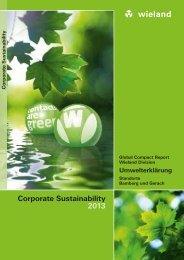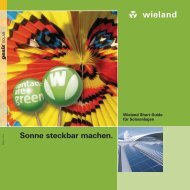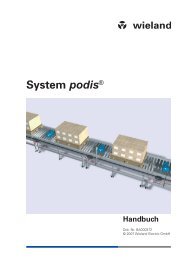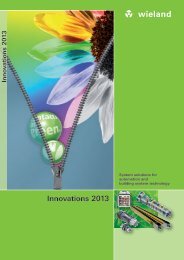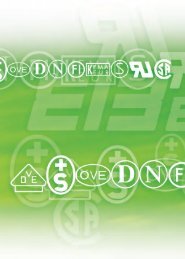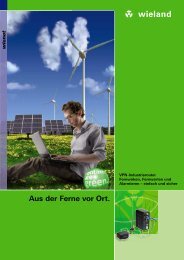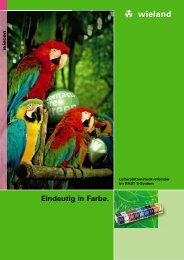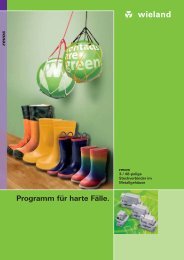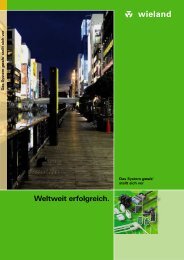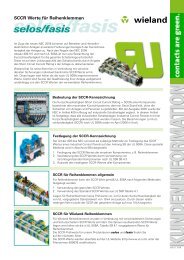Explanations of applications in hazardous areas - Wieland Electric
Explanations of applications in hazardous areas - Wieland Electric
Explanations of applications in hazardous areas - Wieland Electric
Create successful ePaper yourself
Turn your PDF publications into a flip-book with our unique Google optimized e-Paper software.
General<strong>Explanations</strong> <strong>of</strong> <strong>applications</strong> <strong>in</strong> <strong>hazardous</strong> <strong>areas</strong>The device category describes the achieved safety level <strong>of</strong> the device.Category 1 Cont<strong>in</strong>uous, long-term or frequent occurrence <strong>of</strong> explosivehazard atmospheres; very high safety degree; explosivegases may occur when the conta<strong>in</strong>er is empty.Category 2 Occasional occurrence <strong>of</strong> explosive hazard atmospheres;high safety degree; especially when mach<strong>in</strong>es are operat<strong>in</strong>g.Category 3 Rare or short-term occurrence <strong>of</strong> explosive hazardatmospheres; normal safety degree; normally only <strong>in</strong> case <strong>of</strong>fault.¬ WKF 10/350344OII2 GD Ex e II750 V 10° KEMA 01 ATEX 2087 Uw600 V 65 A14–6 AWG12722 Ex e II T6 CI I Zn 1AEx e II T6Hot surfaces <strong>of</strong> devices or device componentsare possible sources <strong>of</strong> ignition andtherefore potential hazards. Depend<strong>in</strong>g onthe maximum surface temperature basedon the ignition temperatures <strong>of</strong> certa<strong>in</strong>gases, temperature classes are assigned toelectrical equipment <strong>of</strong> group II for all types<strong>of</strong> protection.DIN rail term<strong>in</strong>al blocks with protectiontype “e” for <strong>in</strong>creased safety are normallyassigned to temperature class T6.Mark<strong>in</strong>g <strong>of</strong> the equipment:In comb<strong>in</strong>ation with the O mark, themark<strong>in</strong>gs <strong>of</strong> the <strong>Wieland</strong> term<strong>in</strong>al blockshave the follow<strong>in</strong>g mean<strong>in</strong>g:TemperatureclassT1 450T2 300T3 200T4 135T5 100T6 85Omax. surfacetemperatur[°C]Ex equipmentII Device group2 Category/zoneG D Material group/<strong>areas</strong>Kema Name <strong>of</strong> test<strong>in</strong>g <strong>in</strong>stitute…ATEX... Year <strong>of</strong> test<strong>in</strong>g,certificate, consec. no.U Certificate valid forcomponentsIn addition to the ATEX approval, <strong>Wieland</strong> DIN rail term<strong>in</strong>al blockswere approved for the <strong>in</strong>dicated Ex <strong>areas</strong> by the follow<strong>in</strong>g certificat<strong>in</strong>g<strong>in</strong>stitutes <strong>in</strong> North America:– UL-AEx, USA→ UL <strong>in</strong>creased safety AEx e II T6for Class I, Zone 1, Group II C<strong>hazardous</strong> locations– CSA-Ex, Canada→ Class I, Zone 1, Ex e II T6for <strong>hazardous</strong> locationsEx i designIn Ex i <strong>applications</strong> (<strong>in</strong>tr<strong>in</strong>sic circuits)electrical equipment without voltage sources(such as DIN rail term<strong>in</strong>al blocks) doesnot require prototype test certificates andmark<strong>in</strong>g.The use <strong>of</strong> feed-through blocks <strong>in</strong> blue <strong>in</strong><strong>in</strong>tr<strong>in</strong>sic circuits for clear dist<strong>in</strong>ction hasbecome generally accepted. The term<strong>in</strong>alblocks meet the design <strong>of</strong> the blockscertified accord<strong>in</strong>g to Ex e.Accessories:The accessories <strong>of</strong>feredby us for the use with DINrail term<strong>in</strong>al blocks canbe operated accord<strong>in</strong>g tothe ATEX directive andare therefore listed <strong>in</strong> ourcatalog.3
DIN rail term<strong>in</strong>al blocks<strong>Explanations</strong> <strong>of</strong> <strong>applications</strong> <strong>in</strong> <strong>hazardous</strong> <strong>areas</strong>DIN rail term<strong>in</strong>al blocks for <strong>in</strong>stallations with explosion hazard(Ex term<strong>in</strong>als) Protection category Increased safety “e‘”Ex term<strong>in</strong>als are DIN rail term<strong>in</strong>al blocks that have been tested and certified by a European Ex test <strong>in</strong>stituteaccord<strong>in</strong>g toDIN EN 60079-0, VDE 0170-1: Explosionsfähige Atmosphäre - Teil 0: Geräte - Allgeme<strong>in</strong>eAnforderungen (IEC 60079-0:2007); Deutsche Fassung EN 60079-0:2009 (“General requirements”)DIN EN 60079-7, VDE 0170-6: Explosionsfähige Atmosphäre - Teil 7: Geräteschutz durch erhöhteSicherheit „e“ (IEC 60079-7:2006); Deutsche Fassung EN 60079-7:2007 (Protection category:Increased safety “e“)The protection category Increased safety “e” applies to electrical equipment that resists sparks, electric arc<strong>in</strong>g or<strong>hazardous</strong> surface temperatures dur<strong>in</strong>g operation. DIN rail term<strong>in</strong>al blocks thus fall <strong>in</strong>to temperature category T6<strong>in</strong> which electrical equipment at an ambient temperature <strong>of</strong> 40 °C and proper use does not exceed the maximumtemperature (surface temperature) <strong>of</strong> 85 °C.Certify<strong>in</strong>g test <strong>in</strong>stitutes are, for example, the Physikalisch Technische Bundesanstalt PTB <strong>in</strong> Germany, theLaboratoire Central des Industries Electrique LCIE <strong>in</strong> France, the Health and Safety Executive BASEEFA <strong>in</strong> GreatBrita<strong>in</strong>, the EX laboratory <strong>of</strong> ASEV <strong>in</strong> Switzerland, among others.However, for DIN rail term<strong>in</strong>al blocks as <strong>in</strong>complete electrical equipment, only a partial certification is issued.This certificate is the basis for the f<strong>in</strong>al acceptance and certification <strong>of</strong> the complete <strong>in</strong>stallation before it iscommissioned by an expert.The certificate (prototype test certificate) <strong>in</strong>cludes a description <strong>of</strong> the DIN rail term<strong>in</strong>al blocks, <strong>in</strong> which specialrequirements regard<strong>in</strong>g the preparation <strong>of</strong> term<strong>in</strong>al strips are put <strong>in</strong>to place, for example, <strong>in</strong>stall<strong>in</strong>g partitions andend plates when term<strong>in</strong>al blocks are connected <strong>in</strong> series. This <strong>in</strong>formation is also provided <strong>in</strong> our catalog that <strong>in</strong>this case serves as an <strong>in</strong>struction manual.Test CertificateCertificates <strong>of</strong> KEMA, PTB and BVS are available for feed-through term<strong>in</strong>al blocks <strong>of</strong> series WK.., WKF.., WKC..,WKFN.. and ground blocks <strong>of</strong> series WK..SL.., WKF..SL.., WKC..SL.., WKFN..SL.. and revos Ex <strong>in</strong>dustrial multipoleconnectors, if <strong>in</strong>dicated. The certificates <strong>in</strong>dicate the relevant rated values and <strong>in</strong>clude the accessories listed <strong>in</strong> thedescription. The <strong>areas</strong> <strong>of</strong> application are divided <strong>in</strong>to:Group I: <strong>Electric</strong>al equipment for m<strong>in</strong>e open<strong>in</strong>gs with firedamp hazardGroup II: <strong>Electric</strong>al equipment for <strong>hazardous</strong> <strong>areas</strong> except for m<strong>in</strong>e open<strong>in</strong>gs with firedamphazard (for example <strong>in</strong>stallations with explosion hazard for the chemical andpetrochemical <strong>in</strong>dustry).Accord<strong>in</strong>g to a resolution <strong>of</strong> the DEK (Deutsche Elektrotechnische Kommission) term<strong>in</strong>al blocks are also acceptedas electrical equipment for Group I (firedamp protection Ex e I) for which only the <strong>in</strong>creased safety protection type‘e’ for Group II (explosion protection Ex e II) has been certified and vice versa.Ex protected DIN rail term<strong>in</strong>al blocks are identified with the mark<strong>in</strong>g Ex e I and Ex e II and an additional mark<strong>in</strong>gaccord<strong>in</strong>g to ATEX directive 94/9/EG. The complete test certificate with a description is available on request.Protection category “Intr<strong>in</strong>sic safety Ex i”The DIN rail term<strong>in</strong>al blocks can be used <strong>in</strong> Group II (Category 2) and Group 1 (Category M2) equipment, as thestandard requirements are identical <strong>in</strong> this case.It has been generally accepted that feed-through term<strong>in</strong>als <strong>in</strong> <strong>in</strong>tr<strong>in</strong>sic circuits are clearly marked with the bluecolor<strong>in</strong>g <strong>of</strong> the <strong>in</strong>sulated hous<strong>in</strong>g. For <strong>in</strong>tr<strong>in</strong>sic circuits, feed-through term<strong>in</strong>als can be used <strong>in</strong>the standard version and if required are available with blue <strong>in</strong>sulat<strong>in</strong>g hous<strong>in</strong>g.4
DIN rail term<strong>in</strong>al blocks<strong>Explanations</strong> <strong>of</strong> <strong>applications</strong> <strong>in</strong> <strong>hazardous</strong> <strong>areas</strong>Mount<strong>in</strong>g <strong>in</strong>structions for Ex e <strong>applications</strong>:• If feed-through blocks are mounted directly adjacent to other feed-through blocks <strong>of</strong> a different size, or directlyadjacent to ground blocks, the open side <strong>of</strong> the block group <strong>of</strong> the same type must be covered by an end plateor partition.• If adjacent DIN rail term<strong>in</strong>al blocks are jumpered or if jumpered DIN rail term<strong>in</strong>al blocks are positioned next tounjumpered DIN rail term<strong>in</strong>al blocks, a partition plate must be <strong>in</strong>serted between the <strong>in</strong>dividual term<strong>in</strong>al blockgroups or at the beg<strong>in</strong>n<strong>in</strong>g and end <strong>of</strong> a laterally or longitud<strong>in</strong>ally connected term<strong>in</strong>al block (group) <strong>in</strong> orderto meet the specified isolation distances. Notched out and jumper<strong>in</strong>g cross connectors can not be used <strong>in</strong> Ex<strong>areas</strong>.Installation <strong>in</strong>formation• The feed through term<strong>in</strong>al blocks and protective conductor term<strong>in</strong>al blocks are suitable for enclosures for use <strong>in</strong>explosive gas atmospheres or for use <strong>in</strong> the presence <strong>of</strong> combustible dust. For explosive gas atmospheres theseenclosures must satisfy the requirements <strong>of</strong> EN 60079-0 and EN 60079-7.For combustible dust these enclosures must satisfy the requirements <strong>of</strong> EN 61241-0 and EN 61241-1.• If the term<strong>in</strong>al blocks are comb<strong>in</strong>ed with other certified series and sizes and when their accessories are used,the required creepage distances and clearances must be adhered to.• If cables are used whose cross-section is smaller than the nom<strong>in</strong>al cable cross-section, the correspond<strong>in</strong>glower current must be specified <strong>in</strong> the EC prototype test certificate for the complete device.• Due to the heat generated dur<strong>in</strong>g operation at the specified current and at ambient temperatures <strong>of</strong> ≤ 40 °C,the DIN rail term<strong>in</strong>al blocks can be <strong>in</strong>stalled <strong>in</strong> equipment (ma<strong>in</strong>ly distribution and connection boxes) suitablefor temperature class T6. If DIN rail term<strong>in</strong>al blocks are <strong>in</strong>stalled <strong>in</strong> equipment with a temperature class rang<strong>in</strong>gfrom T1 to T5, it must be ensured that the maximum temperature <strong>of</strong> the <strong>in</strong>sulat<strong>in</strong>g parts does not exceed themaximum value <strong>in</strong> the operat<strong>in</strong>g temperature range.• If the DIN rail term<strong>in</strong>al blocks are <strong>in</strong>stalled <strong>in</strong> a hous<strong>in</strong>g with protection type “e” (<strong>in</strong>creased safety) accord<strong>in</strong>g toEN 60079-7, the clearances and creepage distances stated <strong>in</strong> Table 1 must be adhered to.DQS certification for all company sectors• Quality standard as per DIN ISO 9001 <strong>in</strong> Development, Production and Assembly• Cont<strong>in</strong>ued control <strong>of</strong> the quality standard by means <strong>of</strong> regular <strong>in</strong>ternal and external quality audits• Compatible with certificates <strong>of</strong> other countries:– BSI Certificate, Great Brita<strong>in</strong>– SQS Certificate, Switzerland– Aib-V<strong>in</strong>cotte Certificate, Belgium– ÖQS Certificate, AustriaAll <strong>Wieland</strong> components which require A general certification are Aidentified with the A logo.certified, and5
Industrial multipoleconnectors<strong>Explanations</strong> <strong>of</strong> <strong>applications</strong> <strong>in</strong> <strong>hazardous</strong> <strong>areas</strong>revos O-multipole connectors are designed for special <strong>applications</strong> <strong>in</strong> <strong>hazardous</strong> <strong>areas</strong>. Their use <strong>in</strong> zone 0 for<strong>in</strong>tr<strong>in</strong>sic circuits has been approved by the DEKRA EXAM test <strong>in</strong>stitute. The hous<strong>in</strong>gs for the multipole connectorsare manufactured from die cast z<strong>in</strong>c alloy.Operat<strong>in</strong>g <strong>in</strong>structions for the connector series„revos Ex…“A pluggable connection consists <strong>of</strong> a hood, a base as well as a female and male <strong>in</strong>sert.Installation <strong>of</strong> a pluggable connection must be prepared as follows:– Closed bottom hous<strong>in</strong>gs must be fixed with screws to a flat surface us<strong>in</strong>g the available bore holes.– Open-bottom hous<strong>in</strong>gs must be fixed with screws to a flat surface us<strong>in</strong>g the available bore holes.Before fix<strong>in</strong>g the hous<strong>in</strong>g to the surface, ensure that the seal fixed to the base at the time <strong>of</strong>delivery is mounted correctly.– The female <strong>in</strong>sert and male <strong>in</strong>sert must be screwed <strong>in</strong>to the hood (or alternatively screwed <strong>in</strong>to thebase) us<strong>in</strong>g the screws already attached to the frame <strong>of</strong> the male or female connector.– The cables are connected to the male connectors and female connectors us<strong>in</strong>g the screwconnection with a torque <strong>of</strong> 0.5 Nm.The components are made ready for operation by plugg<strong>in</strong>g the hood and base together and latch<strong>in</strong>gthem.The relevant connectors must be mounted to device <strong>in</strong> a way that at least protection degree IP 54accord<strong>in</strong>g to EN 60529 is ensured.The „revos Ex“ connectors are designed for use <strong>in</strong> an ambient temperature range at <strong>in</strong>stallation site<strong>of</strong> –20°C bis +60°C.Usage note:The “revos Ex” plug connector series can be used with a rated voltage <strong>of</strong> 90 V and apermissible cable cross-section <strong>of</strong> 0.5 mm 2 to 2.5 mm 2 for the follow<strong>in</strong>g application <strong>areas</strong>accord<strong>in</strong>g to ATEX directive 94/9/EC and the EN 60079-0:2006, EN 60079-11:2007 andEN 50303:2000 standards:OI M1 Ex ia IPro<strong>of</strong> is provided by the mark<strong>in</strong>g <strong>of</strong> the Ex area on the <strong>in</strong>dividual components <strong>of</strong> the connector.Permissible conductor cross section: 1.5 mm 2 to 2.5 mm 2 at 16 A1.0 mm 2 at 10 A0.75 mm 2 at 6 A0.5 mm 2 at 3 ATranslation <strong>of</strong> the German Operat<strong>in</strong>g <strong>in</strong>structions<strong>Wieland</strong> <strong>Electric</strong> GmbHBrennerstraße 10-14D-96052 BambergGermany6
Industrial multipoleconnectorsactsplanations <strong>of</strong> <strong>applications</strong> <strong>in</strong> <strong>hazardous</strong> <strong>areas</strong>ustrial multipole connectors<strong>Explanations</strong> <strong>of</strong> <strong>applications</strong> <strong>in</strong> <strong>hazardous</strong> <strong>areas</strong>cts & DATA1446 Subject to change without further notice7
facts & DATAHeadquarters:<strong>Wieland</strong> <strong>Electric</strong> GmbHBrennerstraße 10 – 14D-96052 BambergSales- andMarket<strong>in</strong>g Center:<strong>Wieland</strong> <strong>Electric</strong> GmbHBenzstraße 9D-96052 BambergPhone +49 (951) 9324-0Fax +49 (951) 9324-198www.wieland-electric.comwww.gesis.com<strong>in</strong>fo@wieland-electric.comIndustrial technologySolutions for the control cab<strong>in</strong>et• DIN rail term<strong>in</strong>al blocks– Screw, spr<strong>in</strong>g clamp or IDC connectiontechnology– Wire cross sections up to 240 mm 2– Numerous special functions– S<strong>of</strong>tware solutions <strong>in</strong>terfac<strong>in</strong>g toCAE systems• Safety– Safety sensors– Safety relays– Modular safety systems with fieldbus l<strong>in</strong>k• PLC and fieldbus components– Standard <strong>applications</strong> <strong>in</strong> IP 20– Increased environmental conditions withrailroad and ship approvals• Interface– Coupl<strong>in</strong>g relays, semiconductor switches– Measur<strong>in</strong>g and monitor<strong>in</strong>g relays– Timer and switch<strong>in</strong>g relays– Analog modules– Passive <strong>in</strong>terfaces– Power supply units– Overvoltage protectionSolutions for field <strong>applications</strong>• Remote automation technology– Power distribution– Fieldbus <strong>in</strong>terfaces and motor starters• Connectors for <strong>in</strong>dustrial <strong>applications</strong>– Square and round connectors– Alum<strong>in</strong>um or plastic hous<strong>in</strong>gs– Degree <strong>of</strong> protection up to IP 68– Current-carry<strong>in</strong>g capacity up to 100 A– Connectors for <strong>hazardous</strong> <strong>areas</strong>– Modular, application specific technologyPC board term<strong>in</strong>als and connectors– Screw or spr<strong>in</strong>g clamp connection technology– Spac<strong>in</strong>gs: 3.5 mm to 10.16 mm– Reflow or wave solder<strong>in</strong>g processBuild<strong>in</strong>g and <strong>in</strong>stallation technology• Build<strong>in</strong>g <strong>in</strong>stallation systems– Ma<strong>in</strong> power supply connectorsIP 20/IP 65 ... IP 68– Bus connectors– Comb<strong>in</strong>ed connectors– Low-voltage connectors– Power distribution system with flat cables– Distribution systems– Bus systems <strong>in</strong> KNX, LON andradio technology– DIN rail term<strong>in</strong>al blocks forelectrical <strong>in</strong>stallations– Overvoltage protectionP r o d u c t R a n g e



